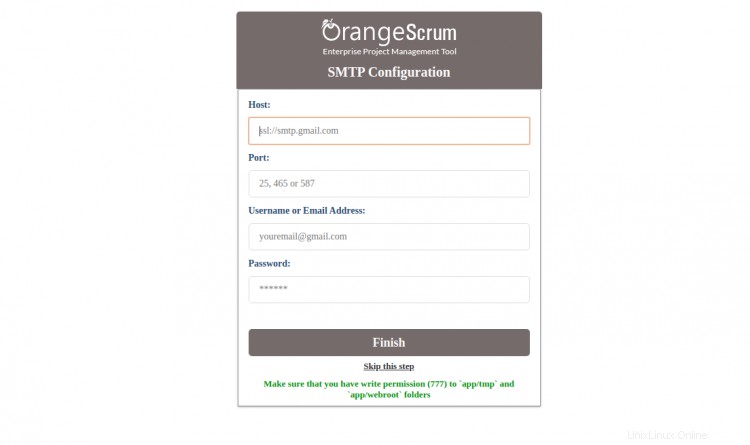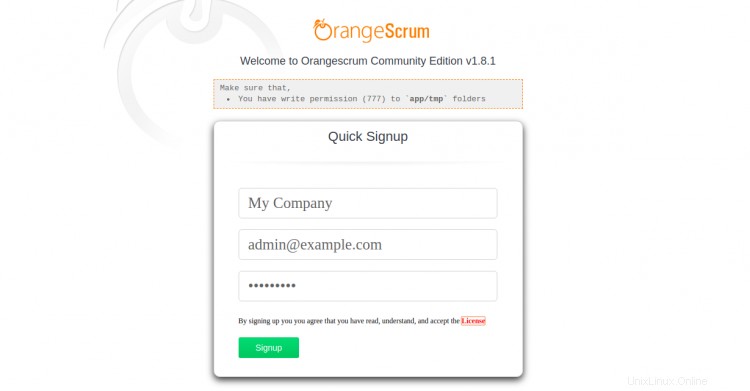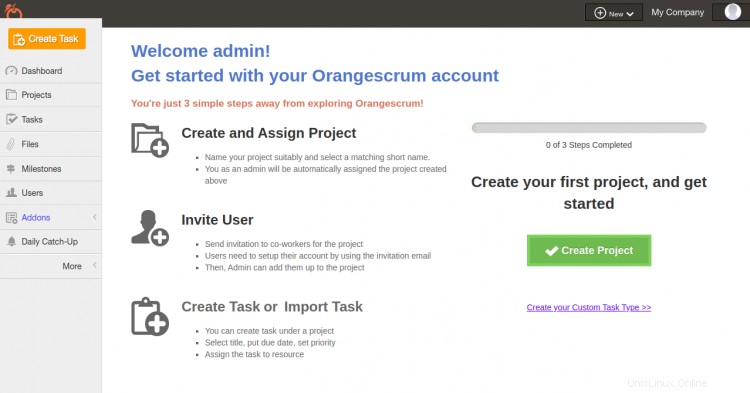Orangescrum es una aplicación de colaboración y gestión de proyectos gratuita y de código abierto. Es ideal para pequeñas y medianas empresas y lo ayuda a crear y administrar sus proyectos, equipos, documentos y tareas y comunicarse con los demás miembros del equipo. Es una aplicación de administración de proyectos muy útil con una interfaz simple que lo ayuda a planificar, organizar y administrar sus tareas para cualquier proyecto. Viene con una gran cantidad de características que incluyen Scrum Board, Sprint Planning and Reports, Story Points, Project Backlog y muchas más.
En este tutorial, le mostraremos cómo instalar la herramienta de gestión de proyectos OrangeScrum en el servidor Ubuntu 20.04.
Requisitos
- Un servidor con Ubuntu 20.04.
- Un nombre de dominio válido apuntado con la IP de su servidor.
- Se configura una contraseña raíz en el servidor.
Instalar Apache, MariaDB y PHP
Primero, instale el servidor web Apache y el servidor de base de datos MariaDB con el siguiente comando:
apt-get install apache2 mariadb-server -y
Después de instalar los paquetes anteriores, deberá instalar PHP versión 7.2 y otras extensiones requeridas en su sistema. De forma predeterminada, Ubuntu 20.04 se envía con la versión 7.4 de PHP, por lo que deberá agregar el repositorio Ondrej en su sistema.
Primero, instale los paquetes requeridos con el siguiente comando:
apt-get install software-properties-common gnupg2 -y
A continuación, agregue el repositorio de Ondrej con el siguiente comando:
add-apt-repository ppa:ondrej/php
A continuación, actualice el repositorio e instale PHP junto con otros paquetes necesarios con el siguiente comando:
apt-get install php7.2 php7.2-bcmath php7.2-cgi php7.2-cli php7.2-common php7.2-curl php7.2-dba php7.2-enchant php7.2-fpm php7.2-gd php7.2-imap php7.2-intl php7.2-ldap php7.2-mbstring php7.2-mysql php7.2-opcache php7.2-imagick php7.2-memcache php7.2-soap php7.2-tidy php7.2-xml php7.2-zip libapache2-mod-php7.2 xvfb libfontconfig wkhtmltopdf unzip wget -y
Una vez que todos los paquetes estén instalados, edite el archivo php.ini y cambie algunas configuraciones requeridas:
nano /etc/php/7.2/apache2/php.ini
Cambie los siguientes valores:
post_max_size = 200M upload_max_filesize = 200M max_execution_time = 300 memory_limit = 512M max_input_vars = 5000 date.timezone = Asia/Kolkata
Guarde y cierre el archivo, luego reinicie el servicio Apache para aplicar los cambios:
systemctl restart apache2
Una vez que haya terminado, puede continuar con el siguiente paso.
Crear una base de datos para OrangeScrum
A continuación, deberá crear una base de datos y un usuario para OrangeScrum. Primero, inicie sesión en el shell de MariaDB con el siguiente comando:
mysql
Una vez que inicie sesión, cree una base de datos y un usuario con el siguiente comando:
MariaDB [(none)]> CREATE DATABASE orangescrumdb;
MariaDB [(none)]> GRANT ALL PRIVILEGES ON orangescrumdb.* TO 'orangescrumuser'@'localhost' IDENTIFIED BY 'password';
A continuación, elimine los privilegios y salga del shell de MariaDB con el siguiente comando:
MariaDB [(none)]> FLUSH PRIVILEGES;
MariaDB [(none)]> exit;
A continuación, deberá deshabilitar el modo estricto para MariaDB. Puede hacer esto creando el archivo disabled_strict_mode.cnf:
nano /etc/mysql/conf.d/disable_strict_mode.cnf
Agregue las siguientes líneas:
[mysqld] sql_mode="IGNORE_SPACE,NO_ZERO_IN_DATE,NO_ZERO_DATE,ERROR_FOR_DIVISION_BY_ZERO,NO_AUTO_CREATE_USER,NO_ENGINE_SUBSTITUTION"
Guarde y cierre el archivo. Luego, reinicie MariaDB para aplicar todos los cambios:
systemctl restart mariadb
Instalar OrangeScrum
Primero, deberá descargar la última versión de OrangeScrum desde su sitio web oficial. Después de descargarlo, descomprima el archivo descargado con el siguiente comando:
unzip orangescrum-master.zip
A continuación, mueva el directorio extraído al directorio raíz de Apache con el siguiente comando:
mv orangescrum-master /var/www/html/orangescrum
A continuación, cambie el directorio a Orangescrum e importe la base de datos de OrangeScrum a su base de datos:
cd /var/www/html/orangescrum
mysql -u orangescrumuser -p orangescrumdb < database.sql
Introduzca la contraseña que ha elegido para el usuario de MySQL 'orangescrumuser' cuando lo solicite el comando mysql.
A continuación, edite el archivo base de datos.php y defina la configuración de su base de datos:
nano app/Config/database.php
Cambie las siguientes líneas:
class DATABASE_CONFIG {
public $default = array(
'datasource' => 'Database/Mysql',
'persistent' => false,
'host' => 'localhost',
'login' => 'orangescrumuser',
'password' => 'password',
'database' => 'orangescrumdb',
'prefix' => '',
'encoding' => 'utf8',
);
}
Guarde y cierre el archivo cuando haya terminado.
A continuación, otorgue los permisos adecuados al directorio orangescrum:
chown -R www-data:www-data /var/www/html/orangescrum
chmod -R 775 /var/www/html/orangescrum
Configurar Apache para OrangeScrum
A continuación, deberá crear un nuevo archivo de configuración de host virtual de Apache para OrangeScrum. Puedes crearlo con el siguiente comando:
nano /etc/apache2/sites-available/orangescrum.conf
Agregue las siguientes líneas:
<VirtualHost *:80>
ServerAdmin [email protected]
DocumentRoot /var/www/html/orangescrum/
ServerName orangescrum.example.com
<Directory /var/www/html/orangescrum/>
DirectoryIndex index.php index.html
AllowOverride All
Allow from all
Order allow,deny
Options Indexes FollowSymlinks
</Directory>
</VirtualHost>
Guarde y cierre el archivo, luego habilite el archivo de host virtual de Apache con el siguiente comando:
a2ensite orangescrum.conf
A continuación, habilite los módulos necesarios con el siguiente comando:
phpenmod mbstring
a2enmod rewrite
a2enmod headers
A continuación, reinicie el servicio Apache para aplicar los cambios:
systemctl restart apache2
Ahora puede verificar el estado de Apache con el siguiente comando:
systemctl status apache2
Deberías obtener el siguiente resultado:
? apache2.service - The Apache HTTP Server
Loaded: loaded (/lib/systemd/system/apache2.service; enabled; vendor preset: enabled)
Active: active (running) since Thu 2020-09-17 15:36:20 UTC; 5min ago
Docs: https://httpd.apache.org/docs/2.4/
Process: 40670 ExecStart=/usr/sbin/apachectl start (code=exited, status=0/SUCCESS)
Main PID: 40689 (apache2)
Tasks: 11 (limit: 2353)
Memory: 47.1M
CGroup: /system.slice/apache2.service
??40689 /usr/sbin/apache2 -k start
??40690 /usr/sbin/apache2 -k start
??40692 /usr/sbin/apache2 -k start
??40694 /usr/sbin/apache2 -k start
??40698 /usr/sbin/apache2 -k start
??40699 /usr/sbin/apache2 -k start
??40700 /usr/sbin/apache2 -k start
??40706 /usr/sbin/apache2 -k start
??40808 /usr/sbin/apache2 -k start
??40809 /usr/sbin/apache2 -k start
??40810 /usr/sbin/apache2 -k start
Sep 17 15:36:20 ubuntu2004 systemd[1]: Starting The Apache HTTP Server...
Asegure OrangeScrum con Let's Encrypt SSL
A continuación, se recomienda asegurar OrangeScrum con Let's Encrypt SSL. Primero, instale el cliente Certbot para administrar el SSL.
apt-get install python3-certbot-apache -y
Después de instalar el cliente Certbot, ejecute el siguiente comando para instalar Let's Encrypt SSL para su dominio:
certbot --apache -d orangescrum.example.com
Se le pedirá que proporcione su correo electrónico y acepte el término del servicio como se muestra a continuación:
Saving debug log to /var/log/letsencrypt/letsencrypt.log Plugins selected: Authenticator apache, Installer apache Enter email address (used for urgent renewal and security notices) (Enter 'c' to cancel): [email protected] - - - - - - - - - - - - - - - - - - - - - - - - - - - - - - - - - - - - - - - - Please read the Terms of Service at https://letsencrypt.org/documents/LE-SA-v1.2-November-15-2017.pdf. You must agree in order to register with the ACME server at https://acme-v02.api.letsencrypt.org/directory - - - - - - - - - - - - - - - - - - - - - - - - - - - - - - - - - - - - - - - - (A)gree/(C)ancel: A - - - - - - - - - - - - - - - - - - - - - - - - - - - - - - - - - - - - - - - - Would you be willing to share your email address with the Electronic Frontier Foundation, a founding partner of the Let's Encrypt project and the non-profit organization that develops Certbot? We'd like to send you email about our work encrypting the web, EFF news, campaigns, and ways to support digital freedom. - - - - - - - - - - - - - - - - - - - - - - - - - - - - - - - - - - - - - - - - (Y)es/(N)o: Y Obtaining a new certificate Performing the following challenges: http-01 challenge for orangescrum.example.com Enabled Apache rewrite module Waiting for verification... Cleaning up challenges Created an SSL vhost at /etc/apache2/sites-available/orangescrum-le-ssl.conf Enabled Apache socache_shmcb module Enabled Apache ssl module Deploying Certificate to VirtualHost /etc/apache2/sites-available/orangescrum-le-ssl.conf Enabling available site: /etc/apache2/sites-available/orangescrum-le-ssl.conf
A continuación, elija si desea o no redirigir el tráfico HTTP a HTTPS como se muestra a continuación:
Please choose whether or not to redirect HTTP traffic to HTTPS, removing HTTP access. - - - - - - - - - - - - - - - - - - - - - - - - - - - - - - - - - - - - - - - - 1: No redirect - Make no further changes to the webserver configuration. 2: Redirect - Make all requests redirect to secure HTTPS access. Choose this for new sites, or if you're confident your site works on HTTPS. You can undo this change by editing your web server's configuration. - - - - - - - - - - - - - - - - - - - - - - - - - - - - - - - - - - - - - - - - Select the appropriate number [1-2] then [enter] (press 'c' to cancel): 2
Escriba 2 y presione Entrar para continuar. Una vez finalizada la instalación, debería ver el siguiente resultado:
Enabled Apache rewrite module Redirecting vhost in /etc/apache2/sites-enabled/orangescrum.conf to ssl vhost in /etc/apache2/sites-available/orangescrum-le-ssl.conf - - - - - - - - - - - - - - - - - - - - - - - - - - - - - - - - - - - - - - - - Congratulations! You have successfully enabled https://orangescrum.example.com You should test your configuration at: https://www.ssllabs.com/ssltest/analyze.html?d=orangescrum.example.com - - - - - - - - - - - - - - - - - - - - - - - - - - - - - - - - - - - - - - - - IMPORTANT NOTES: - Congratulations! Your certificate and chain have been saved at: /etc/letsencrypt/live/orangescrum.example.com/fullchain.pem Your key file has been saved at: /etc/letsencrypt/live/orangescrum.example.com/privkey.pem Your cert will expire on 2020-11-11. To obtain a new or tweaked version of this certificate in the future, simply run certbot again with the "certonly" option. To non-interactively renew *all* of your certificates, run "certbot renew" - If you like Certbot, please consider supporting our work by: Donating to ISRG / Let's Encrypt: https://letsencrypt.org/donate Donating to EFF: https://eff.org/donate-le
Ahora, puede acceder a su sitio web de Open Classifieds de forma segura utilizando la URL https://orangescrum.example.com.
Acceso a OrangeScrum
Ahora, abra su navegador web y escriba la URL https://orangescrum.example.com. Debería ver la pantalla de registro de OrangeScrum:

Proporcione sus detalles de SMTP o haga clic en Omitir este paso botón. Debería ver la siguiente pantalla:

Proporcione su nombre de sitio, correo electrónico, contraseña y haga clic en Registrarse botón. Será redirigido al panel de control de Orangescrum en la siguiente página:

Conclusión
¡Felicidades! ha instalado correctamente OrangeScrum con Let's Encrypt SSL en el servidor Ubuntu 20.04. Ahora puede crear su primer proyecto, invitar a usuarios y crear y asignarles una tarea. Siéntase libre de preguntarme si tiene alguna pregunta.